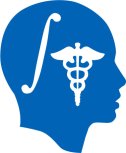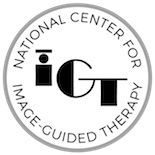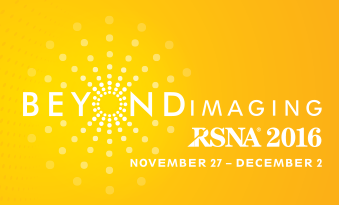RSNA 2016

|

|

|
The events attended by SPL/NA-MIC representatives are listed in the calendar below.
Public Google calendar link: https://calendar.google.com/calendar/embed?src=5s4ugnk036tk9nitmj960m83rk%40group.calendar.google.com
Contents
- 1 Program events
- 1.1 The 3D Slicer Open-source Platform for Segmentation, Registration, Quantitative Imaging and 3D Visualization of Multi-modal Image Data
- 1.2 Interoperable Communication of Quantitative Image Analysis Results Using the DICOM Standard
- 1.3 3D Printing Hands-on with Open Source Software: Introduction (Hands-on)
- 1.4 Knowledge Representation of Prostatic Sector Anatomy from PI-RADS in Standard Lexicons
Program events
The 3D Slicer Open-source Platform for Segmentation, Registration, Quantitative Imaging and 3D Visualization of Multi-modal Image Data
3D Slicer is an open-source software platform for medical image analysis used in clinical research worldwide. The software is freely available and the source code is distributed under a BSD-style open source license with no restriction on use. 3D Slicer is cross-platform and provides clinical researchers easy access to advanced image analysis tools that can be run on their Windows, Mac or Linux laptop computer with their own data. The application provides functionalities for segmentation, registration, automated measurements, quantitative imaging, image display, DICOM interoperability and structured reporting as well as other utilities such as tool tracking and real-time data fusion for image-guided therapy. 3D Slicer integrates quantitative image analysis in the imaging workflow and facilitates the translation of innovative algorithms into clinical research tools. The application is not FDA approved or CE marked, and is for research use only. 3D Slicer is supported by a multi- institution effort of NIH-funded consortia, which include the Neuroimage Analysis Center, the National Center for Image Guided Therapy, and the Quantitative Image Informatics for Cancer Research. In addition, funding from an international community of scientists contributes to some aspect of the software. Over the past 12 years, more than 3,500 clinical researchers have attended 3D Slicer training workshops worldwide. Since its release at RSNA 2011, the latest version of the software 3D Slicer version 4 has been downloaded 189,500 times. The QIRR 3D Slicer exhibit at RSNA 2016 will demonstrate new functionalities of the new 3D Slicer version 4.6.
Teaching Faculty
- Sonia Pujol, Ph.D., Surgical Planning Laboratory, Harvard Medical School, Department of Radiology, Brigham and Women’s Hospital, Boston MA.
- Steve Pieper, Ph.D., Isomics Inc.
- Andrey Fedorov, Ph.D., Surgical Planning Laboratory, Harvard Medical School, Department of Radiology, Brigham and Women’s Hospital, Boston MA.
- Ron Kikinis, M.D., Surgical Planning Laboratory, Harvard Medical School, Department of Radiology, Brigham and Women’s Hospital, Boston MA.
Logistics
- Date: Sunday November 27 -Friday December 2; 8:00am-5:00pm
- Meet-the-expert session: Sunday Nov.27 from 12:30 pm to 1:30 pm; Monday, Nov.28 to Thursday, Dec.1 12:15-1:15 pm.
- Location: Exhibit LL-QRR002, Lakeside Learning Center, McCormick Conference Center, Chicago, IL.
Interoperable Communication of Quantitative Image Analysis Results Using the DICOM Standard
The exhibit will demonstrate support for communication of image segmentation and the quantitative measurements derived from the segmentations, as provided by the following objects defined in the DICOM standard:
- DICOM Segmentation image object (SEG) is representing a classification of pixels in one or more referenced images. Among other capabilities, SEG provides unambiguous specification of the anatomy being segmented using structured terminology.
- DICOM Parametric Map object (PM) can be used to encode floating-point pixel maps of derived parameters, such as results of pharmacokinetic analysis of Dynamic Contrast-Enhanced MRI.
- DICOM Structured reporting template 1500 (SR-TID1500) can be used to communicate measurements over the image region defined by, for example, SEG.
Teaching Faculty
Andriy Fedorov, PhD | Daniel L. Rubin, MD, MS | David A. Clunie, MBBS | David Flade, DIPLENG | Marco Nolden | Chris Hafey | Nicolas Rannou, MSc | Matthias Baumhauer, PhD | Hans Meine | Pattanasak Mongkolwat, PhD | Jayashree Kalpathy-Cramer, MS, PhD | Justin Kirby | Michael Onken | Joerg Riesmeier | Rudolph Pienaar, PhD | Daniel S. Marcus, PhD | Gordon J. Harris, PhD | Steve D. Pieper, PhD | Ron Kikinis, MD | Michael Baumann
Logistics
- Date: Sunday November 27 -Friday December 2; 8:00am-5:00pm
- Meet-the-expert session: Sunday Nov.27 from 12:30 pm to 1:30 pm; Monday, Nov.28 to Thursday, Dec.1 12:15-1:15 pm.
- Location: Exhibit LL-QRR003, Lakeside Learning Center, McCormick Conference Center, Chicago, IL.
3D Printing Hands-on with Open Source Software: Introduction (Hands-on)
LEARNING OBJECTIVES
1) To learn about basic 3D printing technologies and file formats used in 3D printing. 2) To learn how to segment a medical imaging scan with free and open-source software and export that anatomy of interest into a digital 3D printable model. 3) To perform basic customizations to the digital 3D printable model with smoothing, text, cuts, and sculpting prior to physical creation with a 3D printer.
Teaching Faculty
Michael W. Itagaki, MD, MBA Seattle, WA (Moderator) Beth A. Ripley, MD, PhD Seattle, WA (Presenter) Tatiana Kelil, MD Brookline, MA (Presenter) Anish Ghodadra, MD Pittsburgh, PA (Presenter) Hansol Kim, MD Boston, MA (Presenter) Steve D. Pieper, PhD Cambridge, MA (Presenter)
Logistics
- Date: Monday-Thursday 2:30-4:00 PM | RCA24.
- Location: TBD (Check the program)
Knowledge Representation of Prostatic Sector Anatomy from PI-RADS in Standard Lexicons
The PI-RADS Prostate Imaging - Reporting and Data System (PI-RADS v2) standardizes reporting of Multiparametric Magnetic Resonance Imaging (mpMRI). Communication of the precise localization of lesions is important clinically and for research. PI-RADS defines a sector map of the prostate anatomy but not a formal encoding or representation. Manual, semi-automated or automated annotations of lesion locations need to be labeled with pre-coordinated coded anatomical concepts for each sector. It is desirable to define the spatial relationships between these anatomic concepts to facilitate automated knowledge extraction. This abstract describes the definition of concepts corresponding to each of the 36 prostatic sectors defined in the PI-RADS Appendix II Sector Map in the form of an extension to existing medical anatomical ontologies, including the Foundational Model of Anatomy (FMA), SNOMED CT, the NCI Thesaurus and RadLex.
Presenters
- David A. Clunie, MBBS
- Andriy Fedorov, PhD
Logistics
Tuesday 11:40-11:50 AM | SSG07-08
